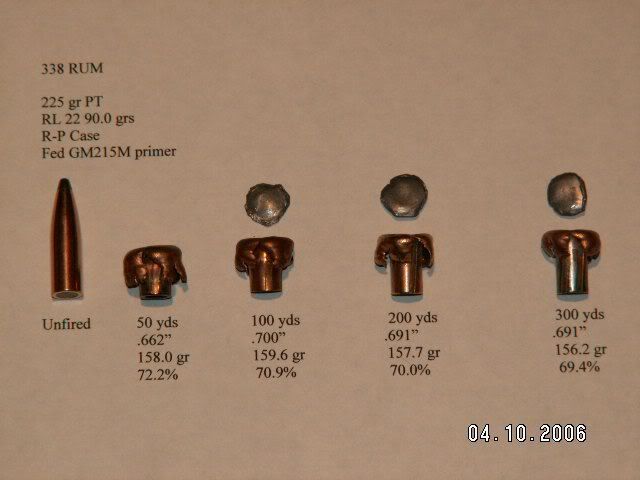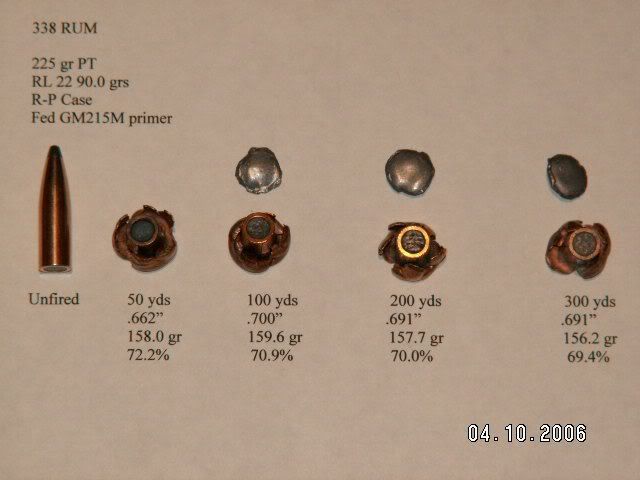Oldtrader3
Ammo Smith
- Nov 6, 2009
- 8,406
- 13
I have tried in the past on this forum to detail my experiences with the various .338 caliber bullets of which I shoot about 300-400+ rounds of a year, in three .338 different calibers (recently) plus, I have been doing so since 1969 with the .338 WM. I realize that this and $3.50 will buy me a Latte nowadays but.... However, there are a couple of things that are important in shooting the .338 WM or .340 type mag type cartridges in particular. Despite the obvious "degrees of freedom" issues with the earlier work that I did using 10-30 cases as a bullet weight sample size, the work was directionally correct and got both my .340 Bee and .338 Federal shooting sub-MOA groups repeatedly and predictably through the sorting of bullets into .3 grain weight groupings.
The primary dependant variable which affects grouping in this caliber of bullets is bullet weight variation, not case weight (2nd level dependency) or COAL (below 2nd dependency). I have weighed a lot of different caliber bullets from different manufacturers over the past 43 years (since 1969) when I got my first .338 WM, and have found that bullets which weigh more than 200 grains and are larger than .318 caliber, vary much more in weight proportionally than smaller bullets do. I already published a small study on this once here on this forum and do not want to bother repeating myself, again!
The most critical dependant variable which predicts accuracy or .338 bullets is in all cases, is bullet weight variation. In weighing .338 caliber bullets from several manufacturers, including Nosler, I have found that very small differences in swaged overall bullet weights make large differences in bullet weight with .338 bullets. By example, a .001 to .002 length variation in a 225 grain, .338 bullet can vary as much as 2.0 grains in bullet weight. This is because of the diameter and the forward ogive position of .338 bullets, compared to bullets that are under .308 caliber and which have much smaller weight variations and more rearward placed ogive radii. In the 225 grain, .338 Partition bullets which I have weighed just in the past two years, I have actually found bullets within a single 50 bullet box of regular Partition bullets which are over 2 grains in actual weight variation. This will affect accuracy, take my word for it, or you can test this hypothesis if you don't believe me.
Because of this extreme weight variation, I always weigh .338 bullets and sort into discrete groups of .3 grains, with extreme outliers (those bullets outside a .9 grain totally variance) being used as foulers or range fodder, not for group testing. Typically within a box of 225 gr or 250 gr Partitions, I will find (3) groupings of .3 grains with a couple of extreme outliers. I am strongly of the opinion that controlling COAL and perhaps weighing cases may help group size control at some level as a measurable dependant variable but if you do not weigh and sort .338 bullets, you will not achieve grouping standards of MOA or better at 300 yards, despite any other control of dependant variables outside of controlling bullet weight. This is of course FWIW.
Charlie
The primary dependant variable which affects grouping in this caliber of bullets is bullet weight variation, not case weight (2nd level dependency) or COAL (below 2nd dependency). I have weighed a lot of different caliber bullets from different manufacturers over the past 43 years (since 1969) when I got my first .338 WM, and have found that bullets which weigh more than 200 grains and are larger than .318 caliber, vary much more in weight proportionally than smaller bullets do. I already published a small study on this once here on this forum and do not want to bother repeating myself, again!
The most critical dependant variable which predicts accuracy or .338 bullets is in all cases, is bullet weight variation. In weighing .338 caliber bullets from several manufacturers, including Nosler, I have found that very small differences in swaged overall bullet weights make large differences in bullet weight with .338 bullets. By example, a .001 to .002 length variation in a 225 grain, .338 bullet can vary as much as 2.0 grains in bullet weight. This is because of the diameter and the forward ogive position of .338 bullets, compared to bullets that are under .308 caliber and which have much smaller weight variations and more rearward placed ogive radii. In the 225 grain, .338 Partition bullets which I have weighed just in the past two years, I have actually found bullets within a single 50 bullet box of regular Partition bullets which are over 2 grains in actual weight variation. This will affect accuracy, take my word for it, or you can test this hypothesis if you don't believe me.
Because of this extreme weight variation, I always weigh .338 bullets and sort into discrete groups of .3 grains, with extreme outliers (those bullets outside a .9 grain totally variance) being used as foulers or range fodder, not for group testing. Typically within a box of 225 gr or 250 gr Partitions, I will find (3) groupings of .3 grains with a couple of extreme outliers. I am strongly of the opinion that controlling COAL and perhaps weighing cases may help group size control at some level as a measurable dependant variable but if you do not weigh and sort .338 bullets, you will not achieve grouping standards of MOA or better at 300 yards, despite any other control of dependant variables outside of controlling bullet weight. This is of course FWIW.
Charlie






